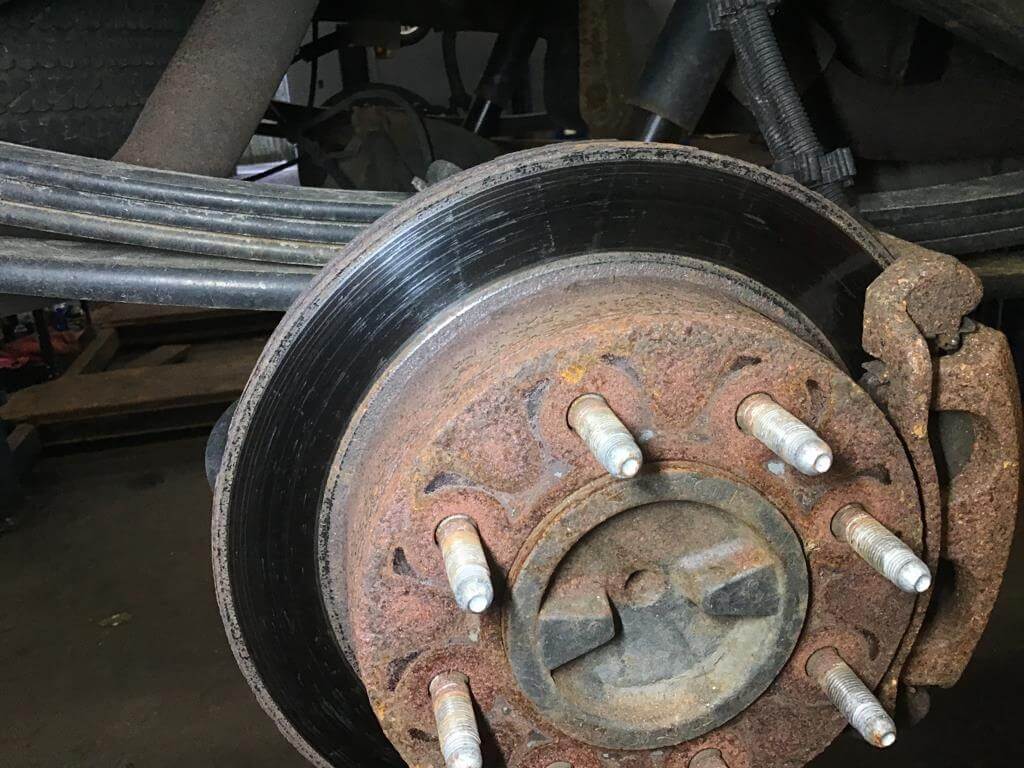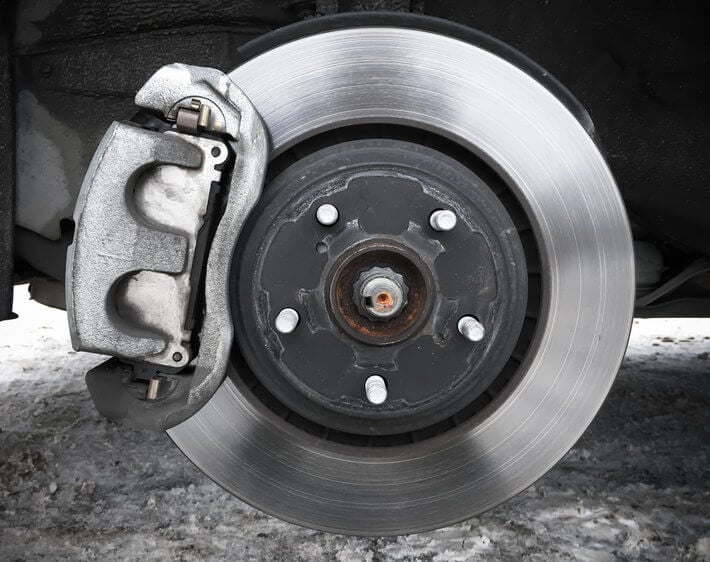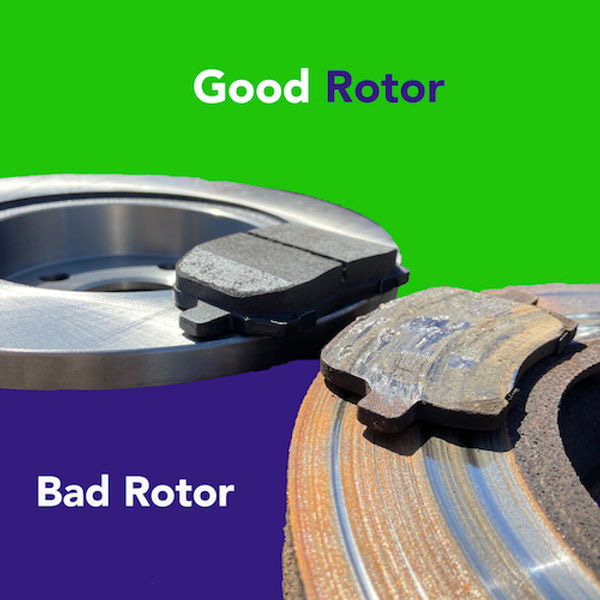To tell if rotors are bad, look for symptoms like pulsation or vibration in the brake pedal and steering wheel, a squealing or grinding noise when braking, or a longer stopping distance. Other signs include uneven wear on the brake pads or a visual inspection revealing deep scoring on the rotor surface.
If any of these indicators are present, it’s likely that the rotors are in need of replacement. Rotors play a crucial role in a vehicle’s braking system, providing the necessary friction to stop the wheels. Over time, rotors can wear down due to constant use and heat buildup, resulting in decreased braking performance.
Detecting a deteriorating rotor early on is important for maintaining safety on the road and preventing more costly repairs down the line. This article will outline some common signs to look out for that may indicate bad rotors.

Credit: vfauto.com
Signs Of Bad Rotors
An important part of maintaining the health of your vehicle’s braking system is keeping an eye out for signs of bad rotors. Rotors, also known as brake discs, play a crucial role in ensuring smooth and effective braking. Over time, rotors can wear down due to constant friction and heat, leading to potential safety issues. By recognizing the signs of bad rotors, you can address the problem promptly and ensure the safety of both you and your passengers.
Vibration While Braking
One of the telltale signs that your rotors may be in need of attention is experiencing vibration while braking. If you feel a pulsating or vibrating sensation through the brake pedal when you apply pressure, it could indicate that your rotors are unevenly worn or warped. This can happen due to excessive heat, causing the metal to warp or become uneven. When applying the brakes, the uneven surface of the rotor causes the brake pads to make inconsistent contact, resulting in the vibration sensation.
Squealing Or Squeaking Noises
Another common sign of bad rotors is the presence of squealing or squeaking noises when you apply the brakes. These high-pitched sounds can be quite alarming, but they serve as an important indication that something is not right with your rotors. The noise is often caused by the brake pads wearing out and the metal indicator rubbing against the rotor. However, it can also be a result of a glazing or hardening of the rotor’s surface, which prevents the brake pads from gripping effectively, leading to the squealing or squeaking noises.
When you notice these signs of bad rotors, it is crucial to take action. Ignoring the problem can lead to further damage to your vehicle’s braking system and compromise your safety on the road. Getting your rotors inspected and replaced, if necessary, by a qualified mechanic can help restore the smooth and reliable braking performance you need.
Inspecting The Rotors
Inspecting the rotors is an essential step in determining whether they are in good condition or need to be replaced. By closely examining the rotors, you can identify any signs of damage or wear that may affect the performance of your vehicle’s braking system. In this section, we will discuss two easy methods to thoroughly inspect the rotors: visual examination and thickness measurement.
Visual Examination
A visual examination allows you to visually assess the condition of the rotors. Start by removing the wheel to gain a clear view of the rotors. Here’s what you need to look for during this inspection:
- Cracks: Look for any visible cracks on the rotor surface. Cracks can weaken the rotor and may lead to failure during braking.
- Deep Grooves or Scores: Check for deep grooves or scores on the rotor. These can indicate excessive wear or the presence of foreign objects that have scratched the surface.
- Uneven Wear: Examine the rotor for any signs of uneven wear. If one area appears significantly more worn than the rest, it may be an indication of a problem with the brake caliper or the brake pads.
- Rust: Rust is not uncommon on rotors, especially if the vehicle has been sitting for an extended period. However, excessive rust may indicate moisture or lack of use, which can affect the rotor’s performance.
By performing a visual examination, you can quickly identify any visible issues that require further attention.
Thickness Measurement
Another way to inspect the rotors is by measuring their thickness. You will need a micrometer or a specialized brake rotor measuring tool to accurately measure the rotor thickness. Here’s the step-by-step process:
- Remove the Rotor: As with the visual examination, remove the wheel to access the rotor effectively.
- Clean the Rotor Surface: Wipe off any debris or dirt from the rotor surface to obtain accurate measurements.
- Measure the Thickness: Use the micrometer or measuring tool to measure the rotor’s thickness at multiple points. Compare the measurements to the manufacturer’s specifications. If the rotor thickness is below the minimum allowed, it is a clear sign that the rotors need to be replaced.
Regularly inspecting the rotors is crucial to ensure the safety and optimal performance of your vehicle’s braking system. By carefully examining the visual signs and measuring the thickness, you can determine whether it’s time to replace the rotors and maintain the efficiency of your brakes.
Driving Symptoms
If you notice your car vibrating or shaking while braking, or hear a grinding noise, these could be signs of bad rotors. Another indication is a pulsating brake pedal when applying pressure. It’s important to address these symptoms promptly to ensure safe and smooth driving experiences.
Brake Pedal Pulsation
If your car’s brake rotors are bad, you might notice a pulsating sensation when pressing on the brake pedal. This can feel like a shaking or vibration coming through the pedal, and it typically occurs when you apply the brakes at higher speeds. The pulsation happens due to uneven rotor surfaces, which can cause the brake pedal to move back and forth as the brakes engage. It’s important to address this issue promptly to ensure safe braking performance.
Reduced Braking Efficiency
Another driving symptom of bad rotors is reduced braking efficiency. You may notice that your car takes longer to come to a complete stop, or the braking power feels diminished. This can occur because the worn or warped rotors are unable to provide optimal friction for the brake pads. Decreased stopping power can lead to dangerous situations, especially in emergency braking scenarios.
Brake Pad Inspection
When checking for signs of bad rotors, it’s vital to start with a thorough Brake Pad Inspection as they are crucial components in your braking system.
Uneven Pad Wear
One common indication of bad rotors is uneven pad wear which can be observed by inspecting the thickness of the brake pads.
Brake Dust And Debris
Inspect for excessive brake dust buildup and debris near the brake pads as they can be signs of rotor issues.
Professional Assessment
Professional Assessment:
Mechanic’s Evaluation
A mechanic’s assessment is crucial to determine the condition of your rotors.
Diagnostic Tools
Diagnostic tools can accurately pinpoint rotor issues for a thorough diagnosis.

Credit: www.yourmechanic.com

Credit: www.tiresplus.com
Frequently Asked Questions For How To Tell If Rotors Are Bad
How Do I Know If My Rotors Need Replacing?
Check for these signs of rotor wear: vibrations or pulsations when braking, uneven braking or pulling to one side, squeaking or squealing noise, or a deep grooving or scoring on the rotor surface. If you notice any of these issues, it’s time to replace your rotors.
What Are Signs Of Bad Rotors?
Signs of bad rotors include vibrations or pulsations in the brake pedal, squealing or grinding noises, reduced braking responsiveness, and uneven wear on brake pads. These symptoms indicate potential rotor damage, which should be inspected and repaired to ensure safe braking performance.
Can You Visually Tell If Rotors Are Bad?
Yes, you can visually tell if rotors are bad. Look for deep grooves, cracks, or an uneven surface. Check for a blue tint, which indicates overheating. Warping can also be visually detected, causing vibration when braking.
How Do You Test Rotors?
To test rotors, conduct a visual inspection for wear or damage, measure thickness and runout, and check for cracks using dye penetrant or magnetic particle testing. Additionally, perform a vibration test to ensure proper balance and function.
Conclusion
Identifying bad rotors is crucial for safe driving. If you notice any symptoms mentioned earlier, it’s essential to get them inspected and replaced if necessary. Regular maintenance can prevent the inconvenience and danger of operating a vehicle with bad rotors.
Don’t delay in addressing any potential issues to ensure smooth and safe driving.
